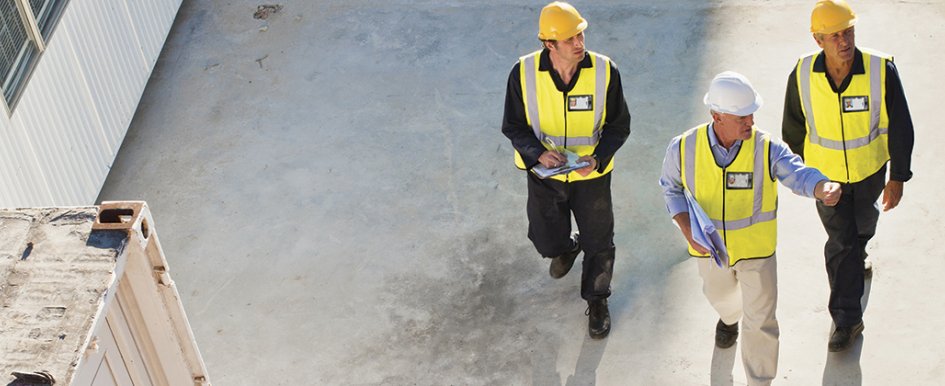
Construction sites are dangerous for workers, and ensuring employee protection can be challenging for employers. To protect employees from on-site dangers, physical health and safety must be managed in the same manner as cost, quality, scheduling and productivity. To avoid major catastrophes, site safety planning must be developed and communicated throughout the organization.
Site planning includes safety and health policies from subcontractors, hazard assessments, activity hazard analysis, safety rules and emergency action plans.
Written programs, such as hazard communication, trenching and shoring, fall protection, lockout tag out, welding and cutting, respiratory hazards and confined space programs. On May 4, 2015, OSHA issued a new standard for construction work in confined spaces, effective August 3, 2015. For more information, visit osha.gov/confinedspaces/faq.html.
Personal protective equipment (PPE), including eye, hand, head, hearing, respiratory, high visibility clothing and footwear protection, should be assessed and provided.
Inspections are also a critical component of these processes and include incident reports, daily general inspections, fire extinguishers, cranes, chains, forklifts and any other heavy equipment.
Employee education provides the basic foundation of safety knowledge for your workforce. Training should include regulatory standards and can also be specific based on hazard analysis.
Insurance requirements should be reviewed. Contractors generally require suppliers, subcontractors and others to maintain insurance against claims or judgments arising from product failure or activities. Insurance is required to protect the contractor, its officers, officials, employees and volunteers. Proof of coverage is normally required in the form of a certificate of insurance that indicates these requirements have been fulfilled.
Contractors' standard agreements should contain a description of the required insurance and an indemnification clause. The indemnification clause automatically takes effect when the contract is signed, but the required insurance does not take effect automatically. It comes into existence only when the other party's insurance company issues the required insurance policies or endorses existing policies to conform to the contractors' requirements. A certificate of insurance does not accomplish these changes. Issuance of a certificate does not guarantee that the implemented changes have actually been made. As the required insurance is not automatic, contractors should require proof that the insurance is in effect before the contract is accepted.
For a safety process to be effective, a companywide effort is required and it starts at the management level. Safety must be communicated throughout the organization and should include input from all levels of management. When developing a health and safety plan, it is important that everyone understands his/her role in implementing and adhering to safety programs and best practices. Clearly communicating safety roles and accountability, as exhibited below, will help ensure successful implementation of safety programs.
- Director of Corporate Safety & Compliance
- Facilitates working relationships with medical resources
- Works closely with the safety coordinator/manager and medical community to manage workers' compensation cases
- Promotes accountability through performance review process
- Establishes methods for correcting the performance of frequently injured employees
- Manager (Senior VP, VP, Project Manager)
- Discusses safety on a daily basis with employees/subcontractors
- Addresses supervisory actions that promote unsafe performance
- Authorizes expenditures for the necessary required PPE
- Reviews all new equipment or chemicals prior to introduction
- Participates in accident investigations, when appropriate, and requires the assembly of a roundtable discussion within 48 hours of any serious incident (recordable or greater)
- Supervisor (Superintendent)
- Ensures that a clearly defined and communicated procedure exists for each routine and non-routine job
- Observes individual job performance for compliance with procedures and the proper use of PPE
- Ensures that each employee has the required PPE readily available and that they understand the use, care and limitations
- Monitors subcontractors to ensure PPE compliance
- Requires the prompt reporting of all incidents, initiates appropriate treatment where injuries are involved and conducts a thorough investigation to include appropriate corrective measures
- Initiates and coordinates a round table discussion for all serious incidents (recordable or greater) within 48 hours of the incident
- Communicates to employees the potential hazards associated with chemicals used in the area. Ensures that subcontractors submit safety data sheet program requirements
- Site Safety Coordinator/Officer
- Administers safety management process by acquiring knowledge of and communicating all elements of the safety process to staff, subcontractors and employees
- Implements, maintains and audits the company safety process
- Compiles periodic reports on the status of safety performance
- Supervises the injury record system, coordinating investigation of injuries, securing supervisors, accident reports and assuring action is taken by management to eliminate accident causes
- Makes personal inspections and supervises inspection procedures for the purpose of discovering and correcting unsafe conditions or unsafe work practices before they cause accidents
- Assures that federal, state or local laws, ordinances or orders bearing on safety are complied with fully
- Ensures company methods and procedures for communicating safety and health matters to employees are effective and they result in employee concerns and suggestions being successfully conveyed and responded to by management
- Audits company safety and training programs to ensure federal or state OSHA required programs are in place with suitable content
- Employees/Subcontractors
- Wears all applicable PPE at all times
- Follows all guidelines established in the Activity Hazard Analysis (AHA) and/or safe practices
- Adheres to site location training guidelines
- Reports all accidents, injuries, unsafe conditions and symptoms of chemical exposure to supervisors immediately
- Knows emergency procedures and role in an emergency
These roles and responsibilities can be tailored to meet each company's varying size, structure and resources. What is most important is establishing a corporate safety culture that empowers employees to work safely and address concerns as they become evident.



